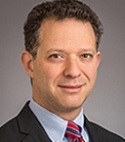Isaac Sacolick, the latest subject in our 'How I Landed my New CIO Job' series, became CIO at Greenwich Associates in January 2015.
Heller Search: What were you looking for in your next CIO role?
Sacolick: Earlier in my career I had successfully launched startups, where I had digital strategy and product development responsibilities as well as technology implementation. I wanted to own product development again. I was missing that element in my work from my startup days. I felt I had the chops; I wanted to get into a company that was undergoing transformation and run digital strategy and product development as well as IT. I didn’t care whether the title was Chief Information Officer or Chief Digital Officer.
I also wanted to work for a company that had customer facing technologies that needed transformational improvements. There is a lot of opportunity for companies that can embrace change, put disciplined practices in to learn customer needs and reimagine their product and service offerings while leveraging new technologies, data capabilities, and digital ecosystems.
Were you actively seeking a new CIO job at the time?
I had been with my previous company since 2007. The business unit I worked in was being sold, which presented me with an opportunity to do some thinking about my future and reevaluate my career objectives. Then I was contacted by an executive recruiter about this position.
What piqued your interest in the opportunity at Greenwich Associates?
A couple things intrigued me. Greenwich Associates is a data business at the heart, which was a good hit. I saw a great brand, a solid reputation and a significant opportunity to transform the way the firm delivered data and advisory services to clients. I was interested in exposure to other industries and I had never worked directly in financial services before.
I had spent the last several years with my team divided between four different locations, and I did a lot of travel. I liked the idea of being part of a team that was in fewer locations and had a strong culture supporting work/life balance
What was Greenwich Associates seeking in their new CIO?
A transformational leader. They recognized that they needed to change how they were operating. They recognized they were making a seismic jump, that technology would play a major role, and that they needed a CIO who could help make what was to be a considerable investment pay off.
Greenwich Associates is a 40-year-old company and there is a lot if intellectual property built up here, a tremendous amount of sophistication around data, analytics, and visualizations. So they also wanted someone who understood data very well, and had successfully led transformational efforts.
What about your professional background was attractive to Greenwich Associates?
I think they saw that I wasn’t a typical infrastructure CIO, that I had a great deal of agile development and data and analytics in my background. They saw that I had led a complex IT transformation that was successful. They learned through the interview process that I was a person of strong integrity and that I could communicate well at a business level.
I am certain that my blogging and twitter activity played a major role. I started my blog “Social, Agile, and Transformation” in 2005, mostly as my way of giving back. In the previous year as a CIO I had worked a lot with agile practices, data science, analytics and digital transformation, and as a result, I blogged about those topics quite a bit.
How did you prepare for your job interviews?
I talked to some friends in the financial services industry to find out what they knew about Greenwich Associates, and of course I did online research, but I find that you walk in to job interviews with incomplete knowledge. So, you have to do a good job listening and find a way to relate to the interviewer, and share the things in your background that relates to what they are talking to you about. More than likely they are going tell you about one of their pain points or something their struggling with. If you are a good fit, you are going to be able to demonstrate that you may be able to solve it.
As you go through the interview process and meet more people, your knowledge builds. After each interview round I reflected back on the areas I could improve, and I got better at it.
What else do you recall from the interview process?
Throughout the interview process, I was gauging their awareness of the size leap they were about to make with the transformation they were planning – the transformation I would be leading if I got the job. How prepared were they to embrace major change? Was there sufficient funding? Are their expectations reasonable? Was everyone on board and supportive of the transformation and did they have a shared vision? I carefully shared with them that, “what you are trying to do is really challenging. It’s big. A similar transformation I have done took several years, and here is why.”
Can you describe the digital transformation they were planning?
Sure. Our business involves interviewing several types of buy-side constituents, capturing their sentiment, who they work with, the products they use, or plan to use, and we leverage the data in consulting services that we provide to banks. The digital transformation is about making our data more accessible in real time, and making it easier for our consultants to find the most valuable information to provide back to clients to enable them to be more highly valued advisors.
The goals include adding more dynamic tools, business intelligence, and the ability for our consultants to crunch data on the fly, quickly revealing insights to share with clients.
And there are new products coming out of this deepened level of client engagement that serve them better. We’ve been able to take services delivered via custom consulting engagements in the past and offer it to more customers as a subscription offering.
How did you prepare to start your new CIO role?
I requested copies of all their documentation behind the transformation initiative. I wanted to arrive on the job already up to speed on the business case, the project plan, and the budget. They had already selected some technology platforms so I did homework to better understand them and why they were selected. And I tried to get an early vantage point on the legacy systems already in place and how difficult it was going to be to integrate or migrate off of them.
Who do you report to at Greenwich Associates?
The CEO. I am part of the eight-person management group for the company, which also includes the CEO, the heads of finance, HR and operations, and the three business sector leads.
What did you face upon the start of your new job?
It was the very beginning of 2015, which turned out to be a bit of an awkward time to have a new CIO start. The budget for 2015 had already been laid out, and a digital business transformation program had been communicated to the rest of the organization as a top priority. I found that several elements of that program were ill-defined and others overpromised.
I spent my first 30 days defining the structure on four programs, which meant giving each one a name, a clear scope and charter, defining governance, roles and responsibilities. Some of the funding was insufficient so I needed to review the budget and look for opportunities. Some of that came from delaying projects included in the 2015 budget with no plan or ROI projection.
I needed to get the business and the IT team communicating better, and turn the IT team, which was doing mostly support, into a development team. People didn’t know what agile was so there was a lot of work to do getting people accustomed to week-to-week discussions, rigorous prioritization, and thinking in terms of releases -- the agile culture. The company had to learn a new definition of what product ownership meant.
What IT organizational changes did you make?
I made changes that were less structural and more about defining roles and responsibilities. This was no longer about keeping the lights on. I needed to quickly roll out an agile practice in our key transformational programs, then hire a head of solutions delivery to insure that we were maturing agile and developing sound architectural practices around our strategic technology platforms.
I had to build a product organization. There were elements of product development happening in our business sectors, but there wasn’t a product development process, or a way to vet ideas. It took us six months to reach consensus on who to hire for a new head of product development position.
I rebranded our group and took out the word “IT.” IT has become the Digital Business Group; application development is now Solution Delivery; IT operations is now Enterprise Services, and we had to introduce Product Development as a formal practice. This was rolled out only a few months ago so it’s still too early to tell what the impact will be.
How do you know when your IT organization is succeeding?
The most important thing is that the team has to be executing. If systems are failing, it undermines our ability to have an effective conversation with our internal partners. We have to demonstrate continuous improvement in our products and services.
And success requires continuous learning, especially about agile in our case. How much learning is what I am teaching to the team versus what they are learning on their own?
To be successful we need leaders, and the most exciting thing is to watch as new leaders emerge on the team, asking questions and learning from their mistakes.
What advice do you have for IT leaders considering a move to a new role and a larger challenge?
First, before they think about the bigger role, I would advise them to define what new challenges they are interested in. It’s different from early in your career when you could try a few different things with few consequences. Now your time is limited so you need to make choices. What is interesting to you? What do you want to steer away from? It’s the hardest thing to be honest about, especially at the CIO level, but it enables you to home in on opportunities that present the challenges you really want to go after – that you’re excited about.
And think creatively about what “larger” means. Metrics like company size and the number of direct reports don’t tell the whole story. The company size and headcount in my IT organization were larger in my last job, but here I have a much bigger charter.
About Isaac Sacolick
 Isaac Sacolick is Greenwich Associates’ Global CIO and a Managing Director. He leads the firm’s Business Transformation Initiative, including implementing new business intelligence platforms, upgrading the firm's CRM processes, and spearheading a digital transformation of marketing practices. Before joining the firm, Isaac was the CIO of McGraw Hill Construction, a leading provider of data, analytics, news and intelligence serving the North American construction industry.
Isaac Sacolick is Greenwich Associates’ Global CIO and a Managing Director. He leads the firm’s Business Transformation Initiative, including implementing new business intelligence platforms, upgrading the firm's CRM processes, and spearheading a digital transformation of marketing practices. Before joining the firm, Isaac was the CIO of McGraw Hill Construction, a leading provider of data, analytics, news and intelligence serving the North American construction industry.
In 2013, Sacolick received TechTarget's CIO award for Technology Advancement. In 2015 and 2014, he was listed on Huffington Post's Top Social CIOs. He is an industry speaker on several business enabling topics including innovation, enterprise agile and big data analytics. He writes a blog, Social Agile and Transformation, which covers topics on CIO technology transformation, agile execution, big data, innovation, and digital marketing, and he tweets as @nyike.
Sacolick holds a bachelor's degree in electrical engineering from Binghamton University, and a master's degree in electrical engineering from the University of Arizona.


Written by Steve Rovniak
Steve Rovniak served as Executive Director, Marketing and Media at Heller Search Associates from 2012 to 2023.



